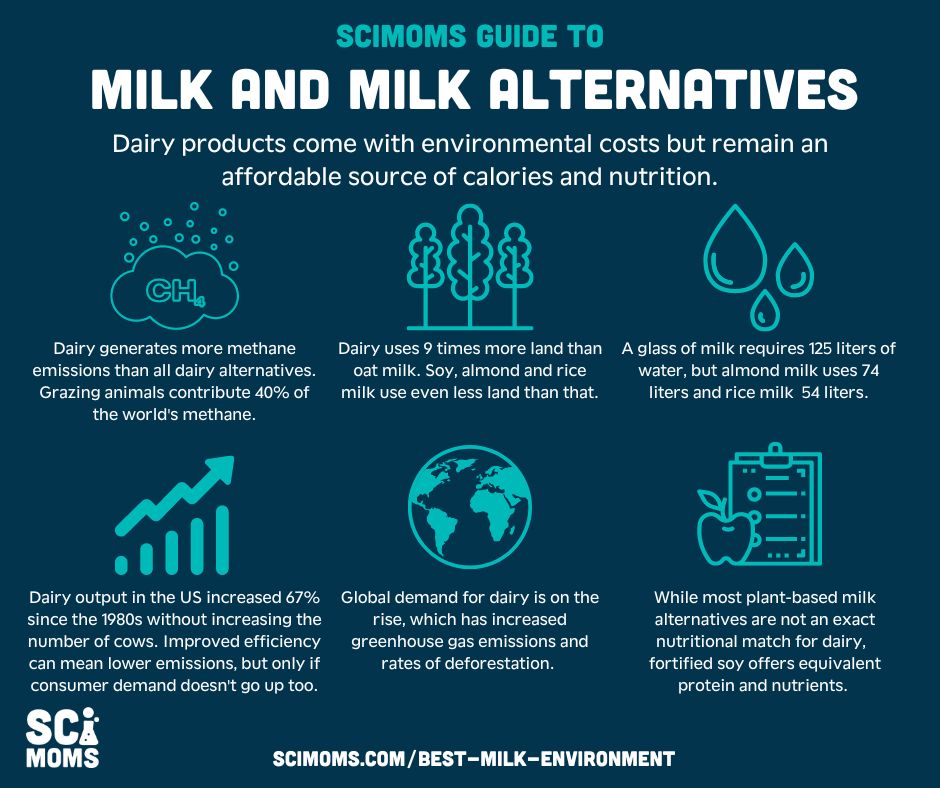
Every bite of food we eat comes at a cost, whether you measure that cost in methane emitted from cow burps, herbicides used to save soybeans from weeds, or hours worked by farm laborers to pick and process food. Some foods come with a higher environmental cost than others. In this post, we look at dairy milk, comparing it to some of the most popular vegan alternatives on the market—soy, oat, and almond—to determine which option is the better choice for the planet. After comparing greenhouse gas emissions, water use, and land-use, we found dairy isn’t the best milk for the environment, though it has other benefits.
The evidence shows dairy milk requires more land and water to produce and creates more greenhouse gas emissions than any plant-based milk on the market. Yet despite these environmental costs, dairy milk remains an affordable source of calories and nutrition, and a dietary staple in many homes.
Dairy is higher in emissions
Glass for glass, dairy milk produces more greenhouse gas emissions than any plant-based alternative, according to a 2018 Oxford study and supplementary data provided by one of the Oxford researchers. Based on emissions data collected by the World Resources Institute, dairy production is higher in greenhouse gas emissions than the equivalent farm to fork production cycle for soy, nuts, rice and legumes like peas, which means dairy isn’t the best milk for the environment.
So how do vegan alternatives compare? According to BBC reporting on the Oxford research, almond milk scores the lowest on greenhouse gas emissions, followed by oat, soy and then rice. The emissions for each of these non-dairy milks all come in at under a third of the emissions for dairy milk. From an emissions perspective then, any non-dairy milk is a better choice for the planet than drinking a glass of cow’s milk.
Methane and land use explained
There are a couple reasons for dairy milk’s high greenhouse gas emissions cost. First, foods that come from a cow, whether beef or dairy milk products, generate more greenhouse gas emissions during production because of the way cows, as ruminant animals, digest their food.
Ruminants have four stomach compartments, one of which is called the “rumen.” Cows break down their food in the rumen through a process called enteric fermentation, in which the rumen ferments what’s inside in order to break it down. Thanks to that process, cows can digest all sorts of food waste that people can’t or don’t want to eat. But that powerful digestive process also comes with a downside. Enteric fermentation causes ruminants to release high levels of the pollutant methane into the atmosphere, mostly in the form of belches, contributing to around 40% of the methane measured globally on an annual basis.
The problem with all that methane is it’s a far more potent greenhouse gas than carbon—around 25 times or 84 times more potent if you measure global warming potential or GWP on a 100 year or 20 year scale. While methane is a short-lived pollutant compared to carbon, lasting only around ten years in the atmosphere, if we continue to increase the number of methane-producing dairy cows worldwide, global methane levels will continue to go up. Because methane traps heat more effectively than carbon, methane can cause more damage while it’s in the atmosphere.
Second, dairy milk has a high emissions cost because of the land required to raise and feed dairy cows. The connection between land and emissions comes from the carbon storage potential that every piece of unused land starts with.
Described as the “carbon opportunity cost,” the theory is that untouched land like forest is a resource for storing carbon in the soil, but once you make the choice to deforest and convert that land into farmland, the opportunity to store carbon is lost as the carbon is released into the atmosphere. Because raising dairy cows requires a lot of land, the carbon opportunity cost for dairy milk is much higher than it is for any plant-based milk. In the past few years, climate-food researchers have begun changing the way they calculate emissions to better account for this lost opportunity to store carbon. That high carbon cost is the reason why environmental researchers argue dairy isn’t the best milk for the environment.
Just how much more land does dairy use?
According to the BBC reporting, producing a glass of dairy milk every day for a year requires 7,000 square feet of land or the equivalent of two tennis courts. Cows require a lot more land for grazing and significant amounts of farmland to grow their feed, either soy or corn, for finishing. Rising demand for beef and dairy milk worldwide has led to agricultural expansion in places like Brazil, which in recent years has been linked to an increase in deforestation. Because many forests are good at storing or sequestering carbon, when you deforest that land and convert it to farmland, you squander its ability to store carbon, releasing the greenhouse gas into the atmosphere.
No milk alternative comes anywhere close to using as much land as dairy milk, according to the Oxford study and supplementary data cited above, which makes any of them a better choice for the environment. It takes about nine times more land to produce a glass of dairy milk than it does to produce the same amount of oat milk, which uses the most land out of the milk alternatives measured. That’s followed by soy, then almond and finally rice.
However, it’s possible for milk alternative companies to have ties to deforestation even if their own ingredients aren’t grown on deforested land. In July, the Swedish oat milk maker Oatly announced it had received a $200 million investment from Blackstone Growth. According to reporting by The Intercept, Blackstone is responsible for heavy deforestation of the Amazon rainforest, as it funded the conversion of land into a highway so that farmers would have a faster route to transport their food.
Dairy uses more water than vegan milks
Even though almond milk requires relatively low greenhouse gas emissions to produce, this particular dairy alternative requires more water during production than many other vegan options. “A single glass requires 74 litres (130 pints of water) — more than a typical shower.” Rice milk also uses a fair amount of water as compared to the other alternatives, “requiring 54 litres of water per glass.”
Despite the higher water use associated with almond and rice milk, both of these vegan milks require less water than dairy milk from a cow, making any of these a better choice for the environment. Using the BBC food impact calculator, drinking a daily glass of cow’s milk for a year costs 45,733 liters of water or 703 showers lasting eight minutes. In comparison to the numbers above, this is 125 liters per glass of dairy milk.
Dairy may not be the best milk for the environment, but it’s not all bad news
Dairy milk production in the U.S. has become a lot more efficient over the years, with numbers of dairy cows decreasing in the 1980s and 1990s at the same time that the U.S. dairy industry was able to produce more milk. Dairy output increased by more than 67% over the course of that time period without adding more cows. In some places, cows also graze on land that is unsuitable for raising other crops and can also eat foods that would otherwise be wasted.
As a result of these improvements, many U.S. dairy farmers and dairy advocates say that their milk isn’t as environmentally damaging as what’s suggested by global emissions models like the ones used by the World Resources Institute. U.S. cattle ranchers raise similar arguments for their beef. Just buy U.S.-raised dairy and beef, they argue.
In response, climate researchers argue that foods like dairy and beef are global commodities, imported and exported around the world, which is why we have to look at emissions from food in a global context. It’s the rising global demand for beef and dairy that is driving deforestation of the Amazonian rainforest, for example, where land is best left untouched to continue storing carbon.
Dairy has other benefits even if it’s not the better choice for the planet
Despite the environmental drawbacks, dairy milk has a lot going for it as a source of nutrition. Milk is a widely available and affordable source of protein and vitamins that isn’t matched entirely by most milk alternatives on the market, though these alternatives are often fortified (just as dairy milk is) to replicate some of those nutrients, like vitamin D, calcium and vitamin B12. If you do prefer plant-based milks, you can still meet your child’s nutritional needs without dairy milk, as fortified soy milk offers the same nutrients.
In particular, dairy milk tends to have more protein than most plant-based alternatives other than soy milk, and it’s also usually cheaper. Some plant-based milks come with high amounts of added sugar to improve taste, so it’s also important to compare nutrition labels. For many parents, dairy milk is one of the easiest and affordable foods for providing their kids with some much-needed nutrition.
Ultimately, the best milk for you and your family is a personal calculation. You may have an almond allergy in the family. Dairy might be the best fit for your nutritional needs. Oat milk might be too expensive. We’re not telling you what to buy, just giving you information.
There also doesn’t have to be one milk to rule them all. Most food-climate researchers who recommend eating less meat or drinking less dairy aren’t insisting that everyone adopt a vegan diet. These researchers usually urge people to try and swap in climate-friendlier alternatives when they can, which may be a far easier burden to bear for those of us who still like our cookies and milk or maybe the occasional slice of a really good aged cheddar. Clothbound, anyone?



You must be logged in to post a comment.